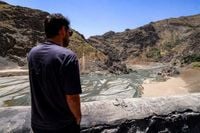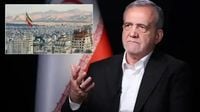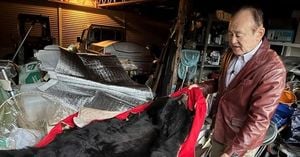Tehran, Iran’s sprawling capital, is staring down the barrel of an unprecedented water crisis that could soon force its millions of residents to ration water—and, in the worst-case scenario, evacuate the city altogether. The warning, delivered by President Masoud Pezeshkian on November 7, 2025, has sent shockwaves through the nation and cast a harsh spotlight on the deeper environmental and economic troubles gripping the country.
“If it doesn’t rain in Tehran by late November, we’ll have to ration water. And if it still doesn’t rain, we’ll have to evacuate Tehran,” President Pezeshkian declared, according to multiple Iranian news outlets and the semi-official SNN.ir agency. His words, described by many as the starkest ever issued by a national leader about a capital city’s viability, came as Tehran’s dam reservoirs plunged to their lowest levels in 60 years, with some holding less than 10% of their capacity.
The numbers paint a grim picture. Tehran, home to around 9.1 million people (with the wider province encompassing up to 15 or even 20 million, depending on the estimate), relies on five major reservoirs: Lar, Mamlu, Amir Kabir, Taleqan, and Latyan. Of these, the Latyan Dam—critical for the city’s water supply—was recently reported to be just 9% full, holding a mere nine million cubic meters of water. “Latyan’s water storage is just nine million cubic meters,” Deputy Energy Minister Mohammad Javanbakht said, calling the situation “critical,” as reported by the Associated Press.
But it’s not just the water supply that’s drying up. Tehran’s energy grid, heavily dependent on hydropower, is faltering as rivers and wetlands vanish. Power output has plummeted, forcing some plants offline for lack of cooling water. The city has entered its sixth consecutive year of drought, with rainfall in 2025 falling about 40% below seasonal norms, according to the Tehran Water Authority. On July 20, officials warned that the capital’s reservoirs had reached their lowest point in a century, and by early November, the authority’s managing director, Behzad Parsa, cautioned that dam reserves could only sustain the city for another two weeks if the dry spell continued.
This dire situation is not isolated to Tehran. Across Iran, 67% of dams are reportedly empty, and the country as a whole is experiencing what officials have described as an “unprecedented” water and energy crisis. The causes are manifold: persistent drought, declining rainfall, and overuse of limited water reserves have all played a part. But experts and critics say government mismanagement and decades of poor policy choices have made matters worse. “High prices and inflation are the fault of the parliament and the government,” President Pezeshkian acknowledged during a speech in Sanandaj, as quoted by Newsweek and other outlets. He linked the water crisis to broader economic troubles, noting that limited financial resources and international sanctions have left many infrastructure projects unfinished.
Long-standing policies have placed water-hungry industries—such as steel, cement, and petrochemicals—in some of Iran’s driest regions. Lawmaker Reza Sepahvand criticized these “wrong policies,” saying they diverted rivers to inland factories that should have been built on the coast. The National Water and Spatial Planning Organization is now urging the relocation of such industries to coastal zones where desalinated water could be used, but change has been slow to materialize.
Meanwhile, agriculture continues to gulp down about 80% of Iran’s freshwater, much of it through inefficient irrigation for thirsty crops in arid areas. “We must modernize,” Agriculture Ministry official Gholamreza Gol Mohammadi warned in August, pointing out that outdated practices are draining aquifers and worsening power outages as pumping systems fail. Experts have long sounded the alarm about false incentives that encourage farmers to grow water-intensive crops rather than adapting to Iran’s arid conditions. The result? Thousands of families have left rural regions, flocking to Tehran and other cities, only to find themselves in an already overburdened system.
The ecological toll of the crisis is mounting. Dust storms now frequently blanket major cities, and the northwest’s Lake Urmia—once one of the world’s largest saltwater lakes—has effectively dried up, leaving behind vast salt flats and worsening dust storms that threaten nearby communities. “In the past 60 years, we have not experienced such low autumn rainfall in Tehran, and the current situation is unprecedented,” said Rama Habibi, head of production operations at Tehran Regional Water Company, underscoring just how extraordinary the current drought has become.
For Tehran’s residents, the crisis is already being felt in their daily lives. Water-saving measures have been imposed, including complete shutdowns in some neighborhoods during late evening and night. Tenants of larger residential complexes have received dramatic warnings about the sharp drop in water pressure and dwindling reserves, urging them to conserve water wherever possible. The idea of relocating the capital—a topic President Pezeshkian has discussed before, given Tehran’s chronic air pollution, soaring prices, and high rents—seems unrealistic to many. Yet, as the water crisis deepens, what once seemed unthinkable is now being openly considered by authorities.
Officials are scrambling for solutions, but time is running out. Without substantial rainfall in the coming weeks, authorities may have no choice but to impose strict water rationing across Tehran, with contingency plans that could include phased restrictions and, if the crisis persists, the evacuation of millions. “If the drought continues, we will run out of water and be forced to evacuate the city,” President Pezeshkian said bluntly, as reported by multiple outlets including Newsweek and the Associated Press.
Some experts and policymakers are calling for much more than emergency measures. They argue that Iran needs long-term reforms, infrastructure upgrades, and tighter controls on agricultural and industrial water use. The link between water availability and electricity generation has become increasingly evident, as hydropower output drops and thermal plants struggle with cooling shortages. Diversifying Iran’s energy system—still highly dependent on hydropower and fossil fuels—has been hampered by sanctions, investor skepticism, and decades of underinvestment. Solar and wind together make up only a small share of total capacity, leaving the country vulnerable to environmental shocks.
For now, the fate of Tehran hangs in the balance, dependent on the whims of the weather and the speed of government action. The unfolding crisis is a stark reminder of the costs of mismanagement, climate change, and the urgent need for adaptation in one of the world’s driest countries. As President Pezeshkian’s warnings echo across the city, Tehran’s residents are left to hope for rain—and brace for whatever comes next.
With reservoirs at historic lows and no relief in sight, Tehran’s water crisis stands as both a national emergency and a cautionary tale for cities facing the harsh realities of a changing climate.





